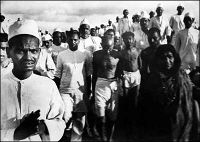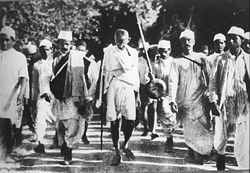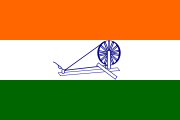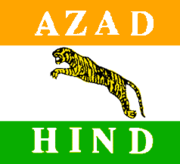Jallianwala Bagh massacre
The Jallianwala Bagh massacre (Punjabi: ਜਲ੍ਹਿਆਂਵਾਲਾ ਬਾਗ਼ ਹਤਿਆਕਾਂਡ, Hindi: जलियांवाला बाग़ हत्याकांड جليانوالہ باغ ہتياکانڈ Jallianwala Bāġa Hatyākāṇḍ), alternatively known as the Amritsar massacre, was named after the Jallianwala Bagh (Garden) in the northern Indian city of Amritsar where, on April 13, 1919, fifty British Indian Army soldiers, under the command of Brigadier-General Reginald Dyer, opened fire on an unarmed gathering of men, women and children. The firing lasted for ten to fifteen minutes, until ammunition was running short. [1] Official British Raj sources placed the fatalities at 379, and with 1,100 wounded.[2] Civil Surgeon Dr Smith indicated that there were 1,526 casualties.[3]
Contents |
Background
India during World War I
World War I began with an outpouring of loyalty and goodwill towards the United Kingdom of Great Britain and Ireland from within the mainstream political leadership of India, contrary to initial British fears of a revolt while they were militarily committed to a European war. British India contributed massively to the British war effort by providing men and resources. About 1.3 million Indian soldiers and labourers served in Europe, Africa, and the Middle East, while both the Indian administration and the princes sent large supplies of food, money, and ammunition. However, Bengal and Punjab remained hotbeds of anticolonial activities. Revolutionary attacks in Bengal, increasingly closely linked with the unrest in Punjab, were significant enough to nearly paralyse the regional administration.[4][5] Also from the beginning of the war, the expatriate Indian population, notably in the United States, Canada, and Germany, headed by the Berlin Committee and the Ghadar Party, attempted to trigger insurrections in India on the lines of the 1857 uprising with Irish republican, German and Turkish help in a massive conspiracy that has since come to be called the Hindu-German conspiracy[6][7][8] This conspiracy also attempted to rally Afghanistan against British India.[9] A number of failed attempts were made at mutiny, of which the February mutiny plan and the Singapore mutiny are the most notable. This movement was suppressed by means of a massive international counterintelligence operation and draconian political acts (including the Defence of India act 1915) that lasted nearly ten years.[10][11]
After the war
In the aftermath of World War I, high casualty rates, soaring inflation compounded by heavy taxation, a widespread influenza epidemic, and the disruption of trade during the war escalated human suffering in India. The costs of the protracted war in both money and manpower were staggering. In India, long the "jewel in the crown" of the British Empire, Indians were restless for independence, having contributed heavily to the war efforts in both money and men. Over 43,000 Indian soldiers had died fighting for Britain.
Indian soldiers smuggled arms into India to overthrow British rule. The prewar Indian nationalist movement revived as moderate and extremist groups within the Indian National Congress submerged their differences in order to stand as a unified front. In 1916, the Congress succeeded in forging the Lucknow Pact, a temporary alliance with the Muslim League over the issues of devolution of political power and the future of Islam in the region.
Prelude to the massacre
The events that followed the passage of the Rowlatt Act in 1919 were also influenced by the events linked to the Ghadar conspiracy. At the time, British Indian Army troops were returning from the battlefields of Europe and Mesopotamia to an economic depression in India.[12][13] The attempts at mutiny in 1915 and the Lahore conspiracy trials were still in public attention. News of young Mohajirs who fought on behalf of the Turkish Caliphate and later fought in the ranks of the Red Army during the Russian Civil War was also beginning to reach India. The Russian Revolution had also cast its long shadow into India.[14] It was at this time that Mahatma Gandhi, until then relatively unknown on the Indian political scene, began emerging as a mass leader.
Ominously, in 1919, the third Anglo-Afghan war began in the wake of Amir Habibullah Khan's assassination and institution of Amanullah Khan in a system blatantly influenced by the Kabul mission. In addition, in India, Gandhi's call for protest against the Rowlatt act achieved an unprecedented response of furious unrest and protests. The situation especially in Punjab was deteriorating rapidly, with disruptions of rail, telegraph and communication systems. The movement was at its peak before the end of the first week of April, with some recording that "practically the whole of Lahore was on the streets, the immense crowd that passed through Anarkali was estimated to be around 20,000."[13]
In Amritsar, more than 5,000 people gathered at Jallianwala Bagh. This situation deteriorated perceptibly over the next few days. Michael O'Dwyer is said to have been of the firm belief that these were the early and ill-concealed signs of a conspiracy for a coordinated uprising around May, on the lines of the 1857 revolt, at a time when British troops would have withdrawn to the hills for the summer. The Amritsar massacre, as well as responses preceding and succeeding it, contrary to being an isolated incident, was the end result of a concerted plan of response from the Punjab administration to suppress such a conspiracy.[15] James Houssemayne Du Boulay is said to have ascribed a direct relationship between the fear of a Ghadarite uprising in the midst of an increasingly tensed situation in Punjab, and the British response that ended in the massacre.[16]
On April 10, 1919, a protest was held at the residence of the Deputy Commissioner of Amritsar, a city in Punjab, a large province in the northwestern part of the then unpartitioned India. The demonstration was held to demand the release of two popular leaders of the Indian Independence Movement, Satya Pal and Saifuddin Kitchlew, who had been earlier arrested by the government and removed to a secret location. Both were proponents of the Satyagraha movement led by Mahatma Gandhi. The crowd was fired on by a military picket, killing several protesters. The firing set off a chain of violence. Later in the day, several banks and other government buildings, including the Town Hall and the railway station were attacked and set on fire. The violence continued to escalate, culminating in the deaths of at least five Europeans, including government employees and civilians. There was retaliatory firing on the crowd from the military several times during the day, and between eighty and twenty people were killed.
For the next two days, the city of Amritsar was quiet, but violence continued in other parts of the Punjab. Railway lines were cut, telegraph posts destroyed, government buildings burnt, and three Europeans were murdered. By April 13, the British government had decided to place most of the Punjab under martial law. The legislation placed restrictions on a number of civil liberties, including freedom of assembly, banning gatherings of more than four people.[17]
The massacre
On April 13, thousands of people gathered in the Jallianwala Bagh (garden) near the Golden Temple in Amritsar, on Baisakhi,
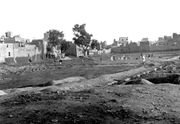
An hour after the meeting began as scheduled at 4:30pm, Brigadier-General Reginald Dyer marched a group of sixty-five Gurkha and twenty-five Baluchi soldiers into the Bagh, fifty of whom were armed with rifles.[18] Dyer had also brought two armoured cars armed with machine guns, however the vehicles were stationed outside the main gate as they were unable to enter the Bagh through the narrow entrance.
The Jallianwala Bagh was bounded on all sides by houses and buildings and had few narrow entrances, most of which were kept permanently locked. The main entrance was relatively wider, but was guarded by the troops backed by the armoured vehicles. General Dyer ordered troops to open fire without warning or any order to disperse, and to direct fire towards the densest sections of the crowd. He continued the firing, approximately 1,650 rounds in all, until ammunition was almost exhausted.
Apart from the many deaths directly from the firing, a number of deaths were caused by stampedes at the narrow gates as also people who sought shelter from the firing by jumping into the solitary well inside the compound. A plaque in the monument at the site, set up after independence, says that 120 bodies were plucked out of the well.
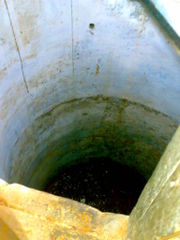
The wounded could not be moved from where they had fallen, as a curfew had been declared - many more died during the night.
The number of deaths caused by the firing is disputed. The official figure given by the British inquiry into the massacre is 379 deaths, however the methodology used in the inquiry is open to criticism. Officials were tasked with finding out who had been killed in July 1919, three months after the massacre, by inviting inhabitants of the city to volunteer information about those who had died.[19] This information was likely incomplete due to fear that those who came forward would be identified as having been present at the meeting.[20] Additionally, a senior civil servant in the Punjab interviewed by the members of the committee admitted that the actual figure could be higher.[21]
Since the official figures were likely flawed considering the size of the crowd (15,000-20,000), close firing-range, number of rounds fired and period of firing, the Indian National Congress instituted a separate inquiry of its own, coming to conclusions that differed considerably from the Government's. The casualty figure quoted by the INC was more than 1,500, with roughly 1,000 killed.[22] Despite the government's best efforts to suppress information of the massacre, news spread elsewhere in India and widespread outrage ensued; however, the details of the massacre did not become known in Britain until December 1919.
Back in his headquarters, General Dyer reported to his superiors that he had been "confronted by a revolutionary army".
In a telegram sent to Dyer, British Lieutenant-Governor of Punjab, Sir Michael O'Dwyer wrote: "Your action is correct. Lieutenant Governor approves."[23]
O'Dwyer requested that martial law be imposed upon Amritsar and other areas; this was granted by the Viceroy, Lord Chelmsford, after the massacre.
Dyer was called to appear before the Hunter Commission, a commission of inquiry into the massacre that was ordered to convene by Secretary of State for India Edwin Montagu, in late 1919. Dyer admitted before the commission that he came to know about the meeting at the Jallianwala Bagh at 12:40 hours that day but took no steps to prevent it. He stated that he had gone to the Bagh with the deliberate intention of opening fire if he found a crowd assembled there.
- "I think it quite possible that I could have dispersed the crowd without firing but they would have come back again and laughed, and I would have made, what I consider, a fool of myself." — Dyer's response to the Hunter Commission Enquiry.[24][25]
Dyer said he would have used his machine guns if he could have got them into the enclosure, but these were mounted on armoured cars. He said he did not stop firing when the crowd began to disperse because he thought it was his duty to keep firing until the crowd dispersed, and that a little firing would do no good. In fact he continued the firing till he ran out of ammunition.[26]
He confessed that he did not take any steps to tend to the wounded after the firing. "Certainly not. It was not my job. Hospitals were open and they could have gone there," was his response.[24]
Demonstration at Gujranwala
Two days later on April 15, demonstrations took place in Gujranwala protesting the killings at Amritsar. Police and aircraft were used against the demonstrators, leading to 12 deaths and 27 injuries. The Officer Commanding the Royal Air Force in India, Brigadier General N D K MacEwen later stated that:
- "I think we can fairly claim to have been of great use in the late riots, particularly at Gujranwala, where the crowd when looking at its nastiest was absolutely dispersed by a machine using bombs and Lewis guns."[27]
Monument and legacy
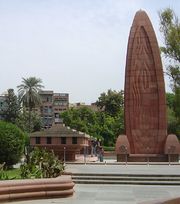
A trust was formed in 1920 to build a memorial at the site following a resolution passed by the Indian National Congress. In 1923, the trust purchased land for the project. A memorial, designed by American architect Benjamin Polk, was built on the site and inaugurated by the then-President of India, Dr Rajendra Prasad on April 13, 1961, in the presence of Jawaharlal Nehru and other leaders. A flame was later added to the site.
The bullet holes can be seen on the walls and adjoining buildings to this day. The well into which many people jumped and drowned attempting to save themselves from the hail of bullets is also a protected monument inside the park.
The massacre is depicted in Richard Attenborough's 1982 film Gandhi with the role of Brigadier Dyer played by Edward Fox. It is also depicted in Indian films Rang De Basanti and The Legend of Bhagat Singh. The story of the massacre also figures in the 7th episode of Granada TV's 1984 series The Jewel in the Crown, recounted by the fictional widow of a British officer who is haunted by the inhumanity of it and who tells how she came to be reviled because she defied the honoring of Dyer and instead donated her monies to the Indian victims.
In 1997, Prince Philip, the Duke of Edinburgh, participating in an already controversial British visit to the Monument, provoked outrage in India with an offhand comment. Having observed a plaque claiming "This place is saturated with the blood of about two thousand Hindus, Sikhs and Muslims who were martyred in a non-violent struggle.", Prince Philip observed, "That's a bit exaggerated, it must include the wounded". (Official British Raj sources placed the fatalities at 379, and with 1,100 wounded.[2] Civil Surgeon Dr Smith indicated that there were 1,526 casualties[3], which might account for the Prince's view on the figure.) When asked how he had come to this conclusion, Prince Philip said "I was told about the killings by General Dyer's son. I'd met him while I was in the Navy." [28]
Assassination of Michael O'Dwyer
On March, 13, 1940, at Caxton Hall in London, Udham Singh, an Indian revolutionary from Sunam who had witnessed the events in Amritsar and was himself wounded, shot and killed Michael O'Dwyer, the British Lieutenant-Governor of Punjab at the time of the massacre, who had approved Dyer's action and was believed to be the chief planner. (Dyer himself had died in 1927.)
The action by Singh was generally condemned, but many Indians as well as people of several other countries felt he had carried out an act of great bravery and some press, like nationalist newspaper Amrita Bazar Patrika, also held positive views. The common people and revolutionary circles glorified the action of Udham Singh. Most of the press worldwide recalled the story of Jallianwala Bagh and held Sir Michael O'Dwyer responsible for the massacre. Singh was called a "fighter for freedom" and his action was referred to in the Times newspaper as "an expression of the pent-up fury of the down-trodden Indian People".[29] In Fascist countries, the incident was used for anti-British propaganda: Bergeret, published in large scale from Rome at that time, while commenting upon the Caxton Hall assassination, ascribed the greatest significance to the circumstance and praised the courageous action of Udham Singh.[30] The Berliner Börsen Zeitung called the event "The torch of Indian freedom". German radio reportedly broadcast: "The cry of tormented people spoke with shots."[31] Fortnightly reports of the political situation in Bihar mentioned: "It is true that we had no love lost for Sir Michael. The indignities he heaped upon our countrymen in Punjab have not been forgotten." In its March 18, 1940 issue, Amrita Bazar Patrika wrote: "O'Dwyer's name is connected with Punjab incidents which India will never forget." The New Statesman observed: "British conservativism has not discovered how to deal with Ireland after two centuries of rule. Similar comment may be made on British rule in India. Will the historians of the future have to record that it was not the Nazis but the British ruling class which destroyed the British Empire?"
Singh had told the court at his trial:
- "I did it because I had a grudge against him. He deserved it. He was the real culprit. He wanted to crush the spirit of my people, so I have crushed him. For full 21 years, I have been trying to wreak vengeance. I am happy that I have done the job. I am not scared of death. I am dying for my country. I have seen my people starving in India under the British rule. I have protested against this, it was my duty. What a greater honour could be bestowed on me than death for the sake of my motherland?"[32]
Singh was hanged for the murder on July 31, 1940. At that time, many, including Jawaharlal Nehru and Mahatma Gandhi, condemned the action of Udham as senseless. However, in 1952, Nehru (by then, Prime Minister) honored Udham Singh with the following statement which had appeared in the daily Partap: "I salute Shaheed-i-Azam Udham Singh with reverence who had kissed the noose so that we may be free." Following this recognition by the Prime Minister, Udham Singh received the title of Shaheed, a name given to someone who has attained martyrdom or done something heroic in the name of their country or religion.
References
- ↑ 1920 [Cmd. 681] East India (disturbances in the Punjab, etc.). "Report of the committee appointed by the government of India to investigate the disturbances in the Punjab, etc." pp. 111-112. (Hereafter referred to as the "Hunter Report".)
- ↑ 2.0 2.1 Home Political Deposit, September, 1920, No 23, National Archives of India, New Delhi; Report of Commissioners, Vol 1, New Delhi
- ↑ 3.0 3.1 Report of Commissioners, Vol 1, New Delhi, p 105
- ↑ Gupta 1997, p. 12
- ↑ Popplewell 1995, p. 201
- ↑ Strachan 2001, p. 798
- ↑ Hoover 1985, p. 252
- ↑ Brown 1948, p. 300
- ↑ Strachan 2001, p. 788
- ↑ Hopkirk 2001, p. 41
- ↑ Popplewell 1995, p. 234
- ↑ Sarkar 1983, p. 169-172,176
- ↑ 13.0 13.1 Swami P (November 1, 1997). "Jallianwala Bagh revisited". The Hindu. http://www.hinduonnet.com/fline/fl1422/14220500.htm. Retrieved 2007-10-07.
- ↑ Sarkar 1983, p. 177
- ↑ Cell 2002, p. 67
- ↑ Brown 1973, p. 523
- ↑ Townshend, Britains Civil Wars. p137
- ↑ Hunter Report, p29
- ↑ Hunter Report, p116-117.
- ↑ Nigel Collett (2007), The Butcher of Amritsar: General Reginald Dyer, Hambledon and London, p. 263
- ↑ Hunter Report, p117
- ↑ "Amritsar Massacre - ninemsn Encarta". Archived from the original on 2009-10-31. http://www.webcitation.org/5kwriIrvt.
- ↑ Disorder Inquiry Committee Report, Vol II, p 197
- ↑ 24.0 24.1 Terence R. Blackburn (2007), A miscellany of mutinies and massacres in India (illustrated ed.), APH Publishing, p. 173, ISBN 9788131301692, http://books.google.com/books?id=yQgt5SYepi8C&pg=PA173
- ↑ Benjamin Guy Horniman (1920), Amritsar and our duty to India, T. F. Unwin, ltd., p. 119, http://books.google.com/books?id=cNpOAAAAMAAJ&pg=PA119&dq=%22without+firing+but+they+would+have+come+back+again%22
- ↑ Benjamin Guy Horniman (1920), Amritsar and our duty to India, T. F. Unwin, ltd., p. 118, http://books.google.com/books?id=cNpOAAAAMAAJ&pg=PA118&dq=%22disperse+the+crowd%22
- ↑ http://www.raf.mod.uk/rafcms/mediafiles/BC18F893_1143_EC82_2E16AC19F19FE2D2.pdf.
- ↑ The Queen in Amritsar
- ↑ The Times, London, March 16, 1940
- ↑ Public and Judicial Department, File No L/P + J/7/3822, Caxton Hall outrage, India Office Library and Records, London, pp 13-14
- ↑ Government of India, Home Department, Political File No 18/3/1940, National Archives of India, New Delhi, p40
- ↑ CRIM 1/1177, Public Record Office, London, p 64
- Brown, Emily (1973), (in Book Reviews; South Asia). The Journal of Asian Studies, Vol. 32, No. 3. (May, 1973), pp. 522-523, Pacific Affairs, University of British Columbia, ISSN 0030851X.
- Brown, Giles (1948), The Hindu Conspiracy, 1914-1917.The Pacific Historical Review, Vol. 17, No. 3. (Aug., 1948), pp. 299-310, University of California Press, ISSN 0030-8684.
- Cell, John W (2002), Hailey: A Study in British Imperialism, 1872-1969, Cambridge University Press, ISBN 0521521173.
- Gupta, Amit K (1997), Defying Death: Nationalist Revolutionism in India, 1897-1938.Social Scientist, Vol. 25, No. 9/10. (Sep. - Oct., 1997), pp. 3-27, Social Scientist, ISSN: 09700293.
- Hoover, Karl. (1985), The Hindu Conspiracy in California, 1913-1918. German Studies Review, Vol. 8, No. 2. (May, 1985), pp. 245-261, German Studies Association, ISBN 01497952.
- Hopkirk, Peter (1997), Like Hidden Fire: The Plot to Bring Down the British Empire., Kodansha Globe, ISBN 1568361270.
- Popplewell, Richard J (1995), Intelligence and Imperial Defence: British Intelligence and the Defence of the Indian Empire 1904-1924., Routledge, ISBN 071464580X, http://www.routledge.com/shopping_cart/products/product_detail.asp?sku=&isbn=071464580X&parent_id=&pc=.
- Sarkar, B.K. (1921), Political Science Quarterly, Vol. 36, No. 1. (Mar., 1921), pp. 136-138, The Acedemy of Political Science, ISSN: 00323195.
- Sarkar, Sumit (1983), Modern India, 1885-1947, Delhi:Macmillan, ISBN 9780333904251.
- Strachan, Hew (2001), The First World War. Volume I: To Arms, Oxford University Press. USA, ISBN 0199261911.
- Tinker, Hugh (1968), India in the First World War and after.Journal of Contemporary History, Vol. 3, No. 4, 1918-19: From War to Peace. (Oct., 1968), pp. 89-107, Sage Publications, ISSN: 00220094.
External links
- An NPR interview with Bapu Shingara Singh - the last known surviving witness.
- Churchill's speech after the incident.
- Amritsar Massacre at Jallianwala Bagh Listen to the Shaheed song of the Amritsar Massacre at Jallian Wala Bagh.
- A description of the Jallianwala Bagh Massacre
- Amritsar Massacre as a turning point in the British Raj - Description and analysis of the Jallianwala Bagh Massacre.
|
||||||||||||||||||||||||||||
